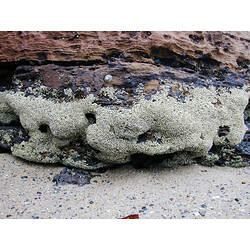General Description
Body concealed within a hard white tube. Feeding tentacles at the opening of the tube are green and white. The tube opening is covered by a flap (operculum) with movable spines. Worm body up to 2 cm long, colonies may be massive.
Biology
Galeolaria Tube Worms form colonies of many worms, providing shelter to smaller invertebrates between and around their tubes. Recent DNA studies have shown that the very common serpulid worm which used to be referred to as Galaeolaria caespitosa in fact comprises two distinct species: the "true" Galaeolaria caespitosa which occurs in south-western Australia to Port Phillip and to Tasmania, while a second species, Galeolaria geminoea, occurs in New South Wales and southern Queensland. Although the two species are genetically very distinct, they cannot be separated morphologically (they look exactly the same). There is a third species in the same genus, Galeolaria hystrix, which is easily distinguished from Galaeolaria caespitosa andGaleolaria geminoea as it has a distinctive crown of red feeding tentacles. It occurs in New South Wales and in New Zealand. It is usually solitary and rarely forms aggregations.
Distribution
New Zealand. Southern and south-eastern Australia.
Habitat
Hard substrates such as intertidal rocky shores and pier piles.
More Information
-
Animal Type
-
Animal SubType
-
Brief Id
White tube, green and white or red tentacles.
-
Colours
White
-
Habitats
-
Diet
Plankton or Particles
-
Endemicity
-
Commercial
No
-
Depths
Shore (0-1 m), Shallow (1-30 m)
-
Water Column Locations
On or near seafloor
-
Taxon Name
-
Scientific Author
Lamarck, 1818
-
Common Name
Intertidal Tube Worm
-
Phylum
-
Class
-
Order
-
Family
-
Subfamily
-
Genus





